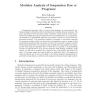198 search results - page 21 / 40 » Lightweight reasoning about program correctness |
AGP
1996
IEEE
14 years 23 days ago
1996
IEEE
Compositional semantics allow to reason about programs in an incremental way, thus providing the formal base for the development of modular data-flow analyses. The major drawback ...
WOTUG
2008
13 years 10 months ago
2008
When teaching concurrency, using a process-oriented language, it is often introduced through a visual representation of programs in the form of process network . These diagrams all...
ASPLOS
2011
ACM
13 years 6 days ago
2011
ACM
nt, user-defined objects present an attractive abstraction for working with non-volatile program state. However, the slow speed of persistent storage (i.e., disk) has restricted ...
TLDI
2010
ACM
13 years 8 months ago
2010
ACM
Interactive programs, such as GUIs or spreadsheets, often maintain dependency information over dynamically-created networks of objects. That is, each imperative object tracks not ...
FOSSACS
2001
Springer
14 years 1 months ago
2001
Springer
Garbage collection relieves the programmer of the burden of managing dynamically allocated memory, by providing an automatic way to reclaim unneeded storage. This eliminates or les...

